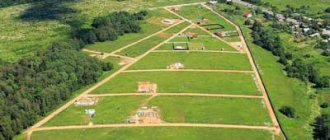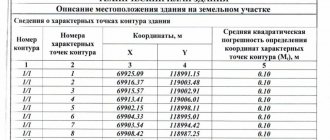Valuation of land plots is one of the most difficult types of work to determine value. This is due to the specifics of land as an object of valuation, the insufficiency of the legislative framework and the underdevelopment of the land market in Russia. At the same time, to determine the market value, all three approaches are used: income, comparative and cost, on the basis of which the methods of land valuation used are determined. To obtain the most accurate estimate, the approaches are used in combination, and the final cost is determined by comparing the results obtained using different methods.
Allocation method in land valuation
Allocation is a method of estimating the value of land used in the income approach to calculate the discount rate. In this case, the rate is determined based on information about concluded transactions for similar real estate objects. The allocation method in land valuation is quite labor-intensive and involves making assumptions about the amount of future income and comparing them with the purchase price.
But the discount rate cannot be obtained solely from information on similar transactions. Using the allocation technique, it is also necessary to determine the expectations of potential buyers (investors) about the rate used in calculating the sales price and regarding projected future cash flows.
As a rule, the procedure for determining the interest rate using the allocation method is carried out in the following sequence:
- Modeling for each similar land plot for a specified time period a scenario for the most efficient use of the expenditure and income portion of cash flows;
- Calculation of the rate of return on investments;
- Processing the results obtained using a statistical or expert method and bringing the characteristics of the analysis into line with assessment standards.
Residual method for land valuation
Expense methods for assessing the market value of land involve the use of techniques for determining the remaining income from a land plot.
The residual method for estimating the value of land can be used both for undeveloped plots and for plots on which real estate is built: shopping centers, industrial, office, residential buildings. In this case, priority in the distribution of income is given to the real estate objects located on the site (buildings and structures), and the remaining income received after reimbursement of the costs of attracting capital, labor and management relates to the income of the land plot.
If the valued object assumes the possibility of receiving income in the form of rent, then the land is assessed using the method of capitalization of land rent. In this case, the value of the object is determined as follows:
- The amount of income (rent) for the assessed land plot is calculated;
- The size of the annuity capitalization ratio is calculated;
- The capitalization of land rent is determined, on the basis of which the market value of the plot is calculated.
Geum.ru
Residual methods allow the estimator to calculate an unknown investment component based on known components. Residual methods are used when working:
1) with financial components (own and borrowed funds);
2) with physical components (land and improvements);
3) with legal components (rights of the tenant and the landlord).
When capitalizing income, the residual technique is used to estimate the value of real estate in cases where the cost and return requirements of one of the elements of the asset - a building (structure) or land - are known.
The amount of income remaining after the known income requirements of a building or piece of land have been satisfied is attributed to another element of the asset. The three most common options for this method are:
- residue technique for land;
- residue technology for buildings;
- residual technique for the property as a whole.
When applying the residual technique for land, the cost of buildings and structures must be known, and the income attributable to the land is determined as the remainder after meeting the income requirements for buildings and structures.
The residual technique for buildings is used when the value of the land is known. The asset balance technique is generally used when the total estimated value of the income stream is known, as well as the proceeds from the resale of the entire asset. General scheme for using residual methods.
1. The cost of a known component is multiplied by the corresponding capitalization rate.
The result is the annual income needed to attract capital to a component of a property of known value. 2. The income received in paragraph 1 for one of the components is deducted from the net operating income (NOI). The result will be the residual income needed to attract capital into the unknown component.3. The residual income is capitalized at the capitalization rate for the component with an unknown cost, resulting in the cost of the latter.
4. The cost of the known component is added to the cost of the remaining component, resulting in the total cost of the item.
Example. The cost of the building is $450,000 and its useful life is 50 years.
The rate of return on investments in the building is 12%, the annual NPV for the 1st year is $65,000. Reimbursement of investments in the building should be carried out using a straight-line method. Determine the total cost of the object.
Solution.
1. The annual rate of return on capital is 100%/50 years = 2% per year.
2. The total required rate of return for a building is 12% (return on investment) + 2% (return on investment) = 14%.3. Income from the building is determined by the formula: P = CHOD / SK; CHOD = R * SK; CHOD = 450,000 * 0.14 = $63,000 4. Balance of CHOD for land: 65,000 - 63,000 = $2,000
5. Valuation of a plot of land (cost of land): P = CHOD / SK; P = 2,000 / 0.12 = $16,666
6. Total property value: 450,000 + 16,666 = $467,000
If the income flow from the building is constant over the years, then income calculations are made using the annuity method:
1) income attributable to the building: P = A * FM4(12%; 50);
A = 450,000 / 8.30447 = $54,188 2) residual income from land: 65,000 - 54,188 = $10,8123) land cost: 10,812 / 0.12 = $90,102
4) total cost of real estate: 450,000 + 90,102 = 540,102 dollars.
The remainder technique is used in determining the best and most efficient use for land, both developed and undeveloped.
In addition, this method can be used when assessing real estate objects that include buildings and structures with insignificant accumulated wear and tear. The actions of the appraiser are as follows.
1. Residual methods are used by the appraiser to estimate the investment value of land plots when considering various development projects, as well as when working in the absence of current data on sales of similar plots.
Thus, the most effective use will be different from the current use. 2. The cost of improvements is estimated as the cost of constructing buildings and structures that correspond to the most efficient use of the land, after which this value is multiplied by the capitalization rate for improvements. The result is the annual income necessary to attract funds from investors in the construction of buildings and structures.3. The income received for improvements is deducted from the expected net operating income (NOI). Residual income represents the income required for investment in land.
4. The value of a land plot is determined as the residual income on land, capitalized at the appropriate rate.
5. The total value of the property is equal to the sum of the cost of the land and improvements.
Example. The appraiser determines the most effective use of the vacant plot of land.
For one possible use case, the NRR is expected to be $90,000 in the first year. The cost of creating the improvements is $400,000. According to the appraiser, the capitalization rates for structures and land are 19% and 13%, respectively. Determine the cost of the land plot Sz, the land component Z, the general capitalization rate Sko.
Solution.
DN = 400,000 * 0.19 = $76,000 - share of improvements in CHOD; Dz = 90,000 -76,000 = $1,400 - share of land in the ChOD; Сз = 14,000 / 0.13 = $107,692; Co = Su + Cz; Co = 400,000 + 107,692 = $507,692; Z = Sz / Co; Z = 107,692 / 507,692 = 21.2%; SD = 90,000 / 597,692 = 0.1772 or SD = 17.7%.
Calculations using the residual technique for buildings are carried out in the opposite direction compared to the residual technique for land. When the value of land can be estimated with a high degree of accuracy from recent comparable sales, the income attributable to the land may be deducted from the NIR.
The resulting balance is the income attributable to buildings and structures, which can be capitalized to assess the value of the latter. The total assessed value of the property is the sum of the value of the land and the capitalized value of buildings and structures.
This method is limited in application and is used to evaluate plots of land with dilapidated buildings and structures.
Using the remainder technique may result in a negative value. For example, the residual technique for land shows a negative amount of residual income attributed to the land. The appraiser needs to check the assumptions in calculating the capitalization rate for both the return on investment and the return on investment.
If the assumptions are correct, then it is likely that the building is an excessive improvement for the site. That is, the income attributed to the building is not capable of providing the required return on investment and return on capital. Or a different approach to property management is required: adjust the rent payment schedule, change the composition of tenants or the level of services provided to them, etc.
If the residual technique for buildings yields a negative value for the building, then after testing the capitalization rate assumptions, the appraiser should make a proposal to change the management of the property, and then to demolish the building and replace it with another that will correspond to the best and most efficient use of the property.
In the technique of remainder, the most appropriate term for property as a whole is reversion. Reversion is the residual value of a property when the income stream ceases. Reversion can be obtained upon expiration of the economically useful life of the object or its resale at an earlier stage.
Based on the material presented, complete task N4 “Income approach to real estate valuation: direct capitalization and discounting of income streams.”
The source data is given in the appendix. 8
.
Distribution method in land valuation
The distribution method in land valuation can only be used for plots on which constructed real estate objects (buildings and structures) are located.
Assessment occurs in the following sequence:
- Elements are identified that will be compared with similar objects;
- The key characteristics and differences of similar objects and the land plot being assessed are established;
- In accordance with the identified differences, price adjustments are made;
- Based on the adjustments, the market value of a complex real estate property (including a land plot) is calculated;
- The market value of the land is determined, equal to the market value obtained at the previous stage, multiplied by the probable share of the land plot in the structure of the cost of a single object.
All the above methods refer to unit assessment methods. At the same time, there are also methods for mass land valuation that make it possible to simultaneously obtain a cadastral valuation of land plots located within the boundaries of areas (regions, cities, etc.) defined by the administrative-territorial structure as of a certain date. Mass methods for assessing urban land are used to determine the tax base, as well as for other purposes established by law.
8.2. Units of comparison
Within strata, landholdings should be analyzed and assessed according to common units of comparison. Sales prices are expressed in unit prices. The selected unit must correspond to the basic parameter by which the analysis and sale of landholdings in this market is carried out.
For residential land, the accepted units of comparison are the plot, the square meter of area, and sometimes the meter of the length of the front boundary. For shops and most other commercial land uses, the square meter of area or meter of frontal extent is usually used, although for large commercial or industrial land uses the square meter of area is often used as the unit of comparison.
For large areas of undeveloped land, another good unit of comparison is the number of structures allowed on a given area, such as the number of residential sites allowed under existing zoning regulations. For agricultural land, the yield of a particular crop per square meter is often used as a unit of comparison.







